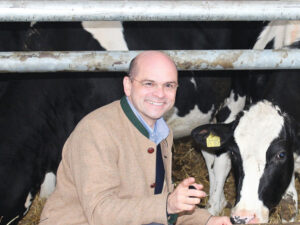Avian influenza has hit dairy farms in at least 12 states after being confirmed in March to have jumped to cattle. The malady, which can curb cows’ milk production and upend dairy farms’ operations, is the latest curveball for an industry that has grappled with low profit margins, drought and shifting consumer tastes.
“Dairy farmers are so stressed to begin with,” said Jason Schmidt, a fifth-generation dairy farmer with 75 cows near Newton, Kan. The threat of bird flu “makes it even harder,” he said.
Officials estimate that an outbreak can curb a farm’s production by 10% to 20% for several weeks, complicating dairy farmers’ efforts to improve profitability after two years of sliding markets. Pressure is growing for the industry to address the spread, with federal health officials warning that continued outbreaks ratchet up the risk to human health.
Federal regulators say the commercial milk supply remains safe and consider the virus low-risk for humans, but people with close contact to infected animals have a greater chance of contracting it. Increased infections could lead the virus to change and pose a greater threat to human health, said Dr. Nirav Shah, the Centers for Disease Control and Prevention’s principal deputy director.
The virus has infected at least 136 herds of cattle across the U.S. and four dairy workers, according to the CDC. Three of the workers experienced eye symptoms, while a fourth had respiratory symptoms. All four recovered.
Officials say the disease is more mild in cows than in poultry, where it is typically fatal and entire farms of birds are destroyed to mitigate outbreaks. Widespread outbreaks among poultry facilities caused egg prices to skyrocket in 2022 and 2023.
As the virus spreads among cows, it is cutting into milk production. The virus has reached at least 26 herds in Idaho, where affected farms are losing up to a fifth of their milk production for three to four weeks. It is costing the average producer in the state $10,000 a day in lost revenue, said Idaho Dairymen’s Association Chief Executive Rick Naerebout.
In Michigan, the flu has reached at least 25 herds, according to the USDA. “There’s a lot of unknowns with how this disease manifests itself in dairy cattle, what this means economically for farms, what the continued human health concerns are around the disease,” said Tim Boring, Michigan’s top agriculture official.
The disease spreads from cow to cow and potentially via vehicles and equipment, officials said. Farmers are looking out for changes in milk production and a “hollow, depressive look” in cattle, said Linda Ceylor, who raises organic, grass-fed dairy cattle on a small Wisconsin farm.
In Michigan, third-generation dairy farmer Ashley Kennedy is trying to boost biosecurity by limiting visitors’ access to her cows and logging the people who enter and exit the farm, as the state requires. In Idaho, Naerebout said farmers treat infected cows with fluids and anti-inflammatory drugs, “just like we do people.”
‘Always fluctuating’
Bird flu outbreaks add to the financial pressure that has been building on dairy farmers. Since rising to $25.46 per hundred pounds of milk in April 2022, futures prices for Class III milk, which is used to make hard cheeses, had declined to $20.03 at the end of June.
Victor Cabrera, a dairy-farm management professor at the University of Wisconsin-Madison, said milk prices haven’t kept up with farmers’ rising costs for feed and labor. The USDA has forecast that 2024 earnings for dairy farms will fall below 2023 and 2022 levels.
As profit margins tighten, farms have consolidated to scale up production and save money on expenses. The number of U.S. dairy farms fell by about a third between 2017 and 2023, according to USDA data, while overall milk production increased slightly.
Farmers who are part of cooperatives—member-owned businesses that process and distribute milk, butter and cheese—often learn what price their milk will fetch after they have already shipped it off. Profit margins can be tough to predict.
“We are the last one to get our share out of that gallon of milk at the grocery store, and then our input prices are also always fluctuating,” said Kennedy, who owns Sheridan Dairy and ships milk from 240 cows to the Michigan Milk Producers Association, a dairy cooperative.
Analysts said they are monitoring the virus, but it hasn’t so far significantly affected dairy markets. “Bird flu is a wild card,” said Lucas Fuess, a senior dairy analyst at Rabobank, adding that it hasn’t affected demand and prices at grocery stores.
On watch for dead birds
The USDA began accepting applications Monday for emergency-assistance funding for farmers who are experiencing milk losses. After regulators confirm a positive H5N1 test result, a producer can recover payments equivalent to 90% of lost milk production over the affected period.
In Texas, farmers aren’t taking up other USDA initiatives, including one that offers up to $2,000 to motivate farmers to adopt testing and biosecurity plans, said Sid Miller, commissioner of the state’s agriculture department.
“It’s not that much money,” Miller said. “It’s not worth the hassle of going through the government red tape and putting yourself in the spotlight of the federal government.”
USDA representatives said 24 herds have been enrolled in the agency’s support programs, and more producers are expected to participate as the USDA ramps up outreach.
Naerebout, of the Idaho producers’ association, said it is in farmers’ business interests to try to prevent the virus. Many are right around the break-even point after roughly 18 months of deflated prices, he said.
If the virus reaches Ceylor’s Hillside Dairy in Wisconsin, it would be a financial hit, she said. Ceylor has been keeping an eye out for groupings of dead birds on her farm where 90 cows graze on 180 acres.
“There’s no way I can physically protect them from this,” Ceylor said. “I do the best that I can.”
Brianna Abbott contributed to this article.
Write to Victor Stefanescu at Victor.Stefanescu@wsj.com






